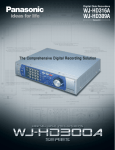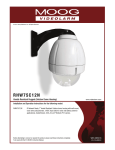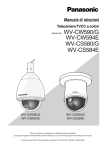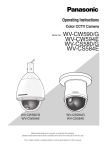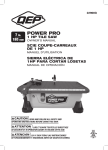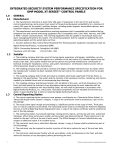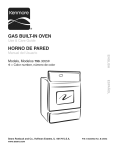Download Bosch LTC 1271 Series Specifications
Transcript
TECHNICAL SPECIFICATIONS: SCOPE OF WORK: The Intent of these specifications is to obtain complete equipment and services (engineering, coordination, outside construction, electrical, installation, testing, clean-up, disposal, supervision, maintenance, monitoring, training, etc.) required for new integrated and fully functional Security Systems for Chippens Hill Middle School. Security systems include Access Control, Intrusion Detection and CCTV components as well as interfacing with existing fire alarm panel(s). Existing Radionics security devices, control panel, door contacts and motion detectors, are to be left in place and incorporated into the new system. Outside construction involves installation of underground conduits from the school building to existing light poles located in the upper parking lot. Installation work shall also provide remote access to the systems from the Bristol Board of Education Office and the Bristol Police Department. Existing construction consists of six (6) building pods to create the Chippens Hill Middle School. Pods are interconnected with expansion joints. Vendor is responsible for providing, as part of the turn-key installation, compliant cable pathways passing through each expansion joint. Refer to the security drawings for locations of the expansion joints. PART 1 - GENERAL 1.1 The Intent of these specifications is to obtain complete equipment and services (engineering, installation, testing, maintenance, etc.) required for security systems for the Bristol Chippens Hill Middle School, provide network access, for video and access control, from the Board of Education and Police Department and interface with existing fire alarm panels. It is required that the contractor integrate existing Radionics systems into the newly installed systems. Additionally, vendor is to coordinate activating monitoring service, for security systems, with the existing service provider, AAA Security Systems, Inc. 675-0427. Project is to include all labor, equipment, installation and clean-up activities, supervision, tools, materials, disposal, testing, training, etc. as required by first-class practice for work of this type; in conformance with all applicable codes; and/or as ordered by the Engineer. Vendor shall be responsible for providing a complete and functional turn-key installation, including all hardware, software, licensing, servers, workstations, racks, backboards and installation of the City of Bristol enterprise anti-virus software. Work includes the installation of any required electrical outlets, for cameras or other equipment, and network cabling between the head-end control equipment and the nearest data network closet. Turn-key installation is meant to also be inclusive of any and all door hardware required to function with the newly installed access control systems(s). Vendor’s network cabling distance between the security head-end and the school’s nearest data panel to be no more than 295 feet at each location. Vendor shall be responsible for the installation, and grounds restoration, of underground conduit between the school building and two (2) existing light poles in the upper parking lot. Pathway is for the installation of new CCTV P/T/Z cameras to be located at these locations. Remote Access Software has been provided, installed and made fully functional under a previous contract. Contractor is responsible for coordinating any required programming to ensure access to the new high school security systems. Board of Education requires, and currently has, access from a single computer in the second floor facilities office using previously installed software. Police Department requires, and currently has, access from a single computer located within the dispatch office using previously installed software. Both locations currently have PCAnywhere installed for the remote access function. The school where new installation performed are is follows: work will be Chippens Hill Middle School, 551 Peacedale Street, Bristol 1.2 RELATED DOCUMENTS A. Each and every Contractor, Subcontractor and/or supplier providing goods or services referenced in or relating to this section shall also be bound by the Drawings and General Provisions of the Contract, including General and Supplementary Conditions which apply to this Section. B. Attached drawings, refer to Appendix A, listed below apply to this and other sections: School Name 1.3 Drawing Number(s) Chippens Hill Middle School SEC 01-04 Detail Drawings SEC 05-06 SUMMARY A. This Section includes the following: 1. Integrated access control and intrusion detection with hard-wired and wireless, multiplexed, modular, microprocessor-based controls, intrusion sensors and detection devices, and communication links to perform monitoring, alarm, and control functions. B. 1.4 1.5 2. Audio/Video Intercom with hardwired, modular components to perform monitoring, viewing, voice communication and selective release of door lock mechanisms. 3. CCTV System with Digital Video Recording. 4. Outside Construction The integrated access control & intrusion detection system must be integrated with the fire alarm system for proper operation of failsafe/fail-secure locking mechanisms. DEFINITIONS A. LCD: Liquid-crystal display. B. VFD: Vacuum Florescent Display. C. LED: Light-emitting diode. D. PIR: Passive infrared. E. RFI: Radio-frequency interference. F. Protected or Protection Zone: A space or area for which an intrusion must be detected and uniquely identified, the sensor or group of sensors assigned to perform the detection, and any interface equipment between sensors and communication link to central-station control unit. G. Standard-Intruder Movement: Any movement, such as walking, running, crawling, rolling, or jumping, of a "standard intruder" in a protected zone. SCOPE OF WORK A. The scope of the design is to control access to the school using electronic security devices and to provide the Board of Education and Police Department remote access to all school access control and CCTV systems in the Bristol Chippens Hill Middle School. Bristol's city-wide computer network consists of local area networks (LAN's) at 24 locations throughout the city including schools and libraries, as well as a wide area network connecting these 24 locations all together. This city-wide network supports the financial systems as well as email and web services. Desktop support is provided to some 1500+ network users in the City departments and schools. Bristol schools share internet access via the Board of Education office. Bristol police department utilizes network access via City Hall. B. Integrated intrusion detection and access control systems shall incorporate a series of proximity card readers, wall/ceiling mounted motion sensors, and door contacts among others. All exterior doors along with several interior doors at the school have existing or shall be fitted with magnetic contact switches. The card readers are located to accommodate access into the buildings by authorized card (or key tag) holders. The specific reader doors will be fitted with electric strike mechanisms and REX motions, and will be interconnected with the access control panel for the door release function. The motion sensors shall be installed in specific locations in order to provide for space protection in various areas as indicated on the attached security drawings. System control will be accomplished through an intelligent LCD keypad interface and/or access credential via the appropriate reader technology. C. Bristol Chippens Hill Middle School is to have access control, motion detection, video intercom and CCTV systems provided and installed, as noted on the security drawings, by the successful vendor. D. Chippens Hill Middle School has existing Radionics motion detection and door contacts wired to a control panel. Radionics control panel is located in the lower level electrical room. It is required for the successful vendor to integrate, and maintain, the existing Radionics systems with the newly provided and installed systems. The existing Radionics control panel must be programmed to send a contact closure when the system is activated. Contact closure will be used to index the Integral system to allow building entrance only to personnel that have both an access card and disarm code. Vendor is responsible for all costs, coordination and equipment related to integrating the existing Radionics systems into the Integral system. Existing Radionics systems are serviced and monitored by AAA Security Systems, 860-675-0427. E. Systems integration will also include the audio/video intercom system. The audio/video intercom system shall have a door release function that will allow for selective door opening from the internal master station. Upon arrival, a visitor will be required to activate the call button on the door station that then opens a communication path between the door station and the internal master. Once communication is established, the person at the internal master station can activate the door release button thereby releasing the electric strike and allowing entry into the building. F. Integrated CCTV systems with digital video recording shall also be installed. Camera locations can be found on the project drawings. The video images supplied by these cameras shall be digitally recorded, and stored for a 30-day period, to allow viewing of both stored and live streaming video from any authorized computer on the network. G. Remote access is to be provided and installed at the Board of Education Facilities office and the Police Department Dispatch office. PC Anywhere software is currently installed in these locations and contractor is responsible that the remote access functions are extended to the Chippens Hill Middle School. Integral Tech Remote View, or equivalent, shall be provided and installed for remote access to CCTV at all school locations. 1.6 H. New systems shall be connected to each school’s LAN using CAT 5e wiring. Provide and install network access jacks local to the existing Andover Control systems. Contractor is responsible for all coordination with the Bristol IT department. I. Vendor will coordinate activating the new security systems with the City of Bristol’s existing monitoring services for fire and security systems. SUBMITTALS A. Product Data: Components for sensing, detecting, access control, systems integration, and control, including dimensions and data on features, performance, electrical characteristics, ratings, and finishes. B. Shop Drawings: Detail assemblies of standard components that are custom assembled for specific application on this Project. 1. Functional Block Diagram: Show single-line interconnections between components including interconnections between components specified in this Section and those furnished under other Sections. Indicate methods used to achieve systems integration. Indicate control, signal, and data communication paths and identify programmable logic controllers, networks and control interface devices and media to be used. Describe characteristics of network and other data communication lines. 2. Raceway Riser Diagrams: Detail raceway runs required for access control, intrusion detection intercom and for systems integration. Include designation of devices connected by raceway, raceway type, and size, and type and size of wire and cable fill for each raceway run. 3. UPS: Sizing calculations to provide a minimum of eight (8) hour battery backup capability, for all systems, server and workstations. 4. Site and Floor Plans: Indicate final outlet and device locations, routing of raceways, and cables inside and outside the building. Include room layout for controlunit backboard, terminal cabinet(s), racks, and UPS. 5. Alarm Control-Unit showing required identification. 6. Audio/Video Intercom Control Layout: At full scale, showing required artwork and device identification. 7. System Wiring Diagrams: Include system diagrams unique to Project. Show connections for all devices, components, and auxiliary equipment. Include diagrams for equipment and for system with all terminals and interconnections identified. 8. Details of surge-protection their installation. 9. Sensor ranges. detection Layout: At full artwork and patterns scale, device devices and and adjustment C. Equipment and System Operation Description: Include method of operation and supervision of each component and each type of circuit. Show sequence of operations for manually and automatically initiated system or equipment inputs. Description must cover this specific Project; manufacturer's standard descriptions for generic systems are not acceptable. D. Qualification Data: For installer and intrusion detection systems integrator. E. Operation and Maintenance Data: For access control, intrusion detection, and intercom system(s) to include in emergency, operation, and maintenance manuals 1. 1.7 Include data for each type of product, including features and operating sequences, both automatic and manual. F. Warranties: Section. Special warranties specified in this G. Other Information Submittals: 1. Test Plan and Schedule: Test plan defining all tests required to ensure that the system meets technical, operational, and performance specifications within seven (7) days of date of Contract award. 2. Response and Report: Response plan shall detail proposed response time and action for various alarm signals. Report plan shall detail proposed monthly reporting of all alarm activity. QUALITY ASSURANCE A. Installer Qualifications: A certified technician accredited by the National Burglar & Fire Alarm Association who is an authorized service representative of central-station control-unit manufacturer. B. Manufacturer Qualifications: A qualified manufacturer. Maintain a service center capable of providing training, parts, and emergency maintenance repairs for overall system at Project site with eight hours' maximum response time. C. Systems Integrator Qualifications: An experienced intrusion detection equipment supplier and Installer, who has completed systems integration work for installations similar in material, design, and extent to that indicated for this Project, and whose work has resulted in construction with a service performance. record of successful in- D. Product Options: Drawings indicate size, profiles, and dimensional requirements of access control, detection devices and central-station control units, and intercom system components, and are based on the specific system indicated. E. Electrical Components, Devices, and Accessories: Listed and labeled as defined in NFPA 70, Article 100, by a testing agency acceptable to authorities having jurisdiction, and marked for intended use. F. Comply with NFPA 70. G. Service: Vendor must have a 24/7 service department available for immediate dispatch. 1. Vendor must provide a maximum of four (4) hour service response time on system problems and eight (8) hour service response time on all peripheral devices. Note that hours are clock hours and not business hours. 2. Vendor will maintain installed equipment. and service all 3. All repair parts shall be fully guaranteed for the duration of this contract and subsequent renewals. 4. Any repair part, or equipment, shall be new manufacturer. 1.8 replacement of and of same PROJECT CONDITIONS A. Environmental Conditions: Capable of withstanding the following environmental conditions without mechanical or electrical damage or degradation of operating capability: 1. Altitude: Sea level to 4,000 feet (1,220m). 1.9 1.10 2. Interior, Controlled Environment: System components, except central-station control unit, installed in air-conditioned, temperature-controlled interior environments shall be rated for continuous operation in ambients of 36 to 122 deg F (2 to 50 deg C) dry bulb and 20 to 90 percent relative humidity, non-condensing. 3. Interior, Uncontrolled Environment: System components installed in non-air-conditioned non-temperature-controlled interior environments shall be rated for continuous operation in ambients of 0 to 122 deg F (minus 18 to plus 50 deg C) dry bulb and 20 to 90 percent relative humidity, noncondensing. 4. Exterior Environment: System components installed in locations exposed to weather shall be rated for continuous operation in ambients of 0 to plus 122 deg F (minus 18 to plus 50 deg C) dry bulb and 20 to 90 percent relative humidity, condensing. Comply with UL 294 and UL 639 for outdoor-use equipment. Rate for continuous operation when exposed to rain as specified in NEMA 250, winds up to 85 mph (137 km/h) and snow cover up to 24 inches (610 mm) thick. WARRANTY A. Special Warranty: Manufacturer's standard form in which manufacturer and Installer agree to repair or replace intercom, access control, and intrusion detection devices and equipment that fails in materials or workmanship within specified warranty period. B. Warranty Period: Minimum two (2) years from date of Substantial Completion. EXTRA MATERIALS A. Furnish extra materials described below that match products installed and that are packaged with protective covering for storage with labels describing contents. and identified 1. Access Control, Intrusion Detection, and Intercom Devices: Furnish quantity equal to five percent of the number of units of each type installed, but no fewer than one of each type, control panels excluded. 2. Fuses: 3. Security one (1) fraction security Three of each kind and size. Fasteners: Furnish not less than box for every fifty (50) boxes, or thereof, of each type and size of fastener installed. PART 2 - PRODUCTS 2.1 MANUFACTURERS A. In other Part 2 articles where titles below introduce lists, the following requirements apply for product selection: Available Manufacturers: Subject to compliance with requirements, manufacturers offering products that may be incorporated into the Work include, but are not limited to, the manufacturers specified. Manufacturers: Subject requirements, provide manufacturers specified. to compliance products by with the Where the term "no equivalent' is used, related to a specific product, no substitution for the particular product will be accepted. 2.2 SYSTEM COMPONENT REQUIREMENTS A. Compatibility: Access Control, Detection devices and their communication features, connecting wiring, and central-station control unit shall be selected and configured with accessories for full compatibility with the following equipment: Interface with Existing Fire Alarm System(s). B. Surge Protection: Protect components from voltage surges originating external to equipment housing and entering through power, communication, signal, control, or sensing leads. Include surge protection for external wiring of each conductor entry connection to components. Minimum Protection for Power Lines 120V and more: Auxiliary panel suppressors complying with requirements in NEC code. Minimum Protection for Communication, Control, and Low-Voltage Power Lines: Signal, Comply with requirements in NEC code and as recommended by manufacturer for type of line being protected. 2.3 C. Interference Protection: Components shall be unaffected by radiated RFI and electrical induction of 15V/m over a frequency range of 10 to 10,000 MHz and conducted interference signals up to 0.25-V RMS injected into power supply lines at 10 to 10,000 MHz. D. Tamper Protection: Tamper switches on detection devices, control units, annunciators, and other system components shall initiate a tamper-alarm signal when unit is opened or partially disassembled and when entering conductors are cut or disconnected. Central-station control-unit alarm display shall identify tamper alarms and indicate locations. E. Self-Testing Devices: Automatically test themselves periodically, but not less than once per hour, to verify normal device functioning and alarm initiation capability. Devices transmit test failure to central-station control unit. F. Anti-masking Devices: Automatically check operation continuously or at intervals of a minute or less, and use signal-processing logic to detect blocking, masking, jamming, tampering, or other operational dysfunction. Devices transmit detection of operational dysfunction to central-station control unit as an alarm signal. G. Addressable Devices: Transmitter and receivers shall communicate unique device identification and status reports to central-station control unit. ENCLOSURES A. Interior Sensors: Enclosures against dust, falling dirt, and corrosive liquids. B. Interior Electronics: that protect dripping non- NEMA 250, Type 12. C. Exterior fiberglass. 2.4 2.5 Electronics: NEMA 250, Type 4X D. Corrosion Resistant: NEMA 250, Type 4X PVC. E. Screw Covers: Where enclosures are accessible, secure with security fasteners of type appropriate for enclosure. ELECTRICAL POWER A. Normal System Power Supply: 120V, 60 Hz, through a locked disconnect device and an isolation transformer in subscriber control unit. Subscriber control unit shall supply power to all components connected to it, unless otherwise indicated. B. Annunciation: Indicate a change in system condition and switching of system or component to backup power. C. UPS: Minimum of eight (8) hour battery backup capability for all systems, sub-systems, servers and workstations. SECURE AND ACCESS DEVICES A. Acceptable Manufacturers: Andover Controls - no equivalent Integral Technologies - no equivalent HID - no equivalent Intellisense - no equivalent Aiphone - no equivalent Ademco - no equivalent George Risk Industries, Inc. - no equivalent 2.6 ACCESS CONTROL ALARM MONITORING SYSTEM A. ACAM file server shall be Integral Technologies Continuum SE® security management system, with no equivalent, complete with CPU, keyboard, 17" LCD color monitor, all required database management, configuration software, database storage system software and hardware, as well as complete browser based ACAM software package including a dynamic alarm graphical user interface. The ACAM system shall also support video badging system Interface, CCTV subsystem interface, elevator control, high integrity dial-up, and other subsystem functions as defined in the specifications and contract documents. ACAM file server shall communicate with ACAM workstations over an industry standard Ethernet local area network (LAN). Location of ACAM file server shall be co-located with the security system head-end and as specified in contract documents and drawings. B. ACAM workstation shall be Integrated Technologies Continuum SE® security management system, with no equivalent, 17" LCD color monitor and keyboard for database entry, operator requested reports and alarm/event reporting. Operator interface shall be browser-driven through easy to understand screens with point and click buttons. ACAM workstation shall communicate with ACAM server over an industry standard Ethernet LAN. One (1) workstation shall be located in the school's Main Office with an exact location coordinated by the vendor and school official. C. D. Dynamic alarm color graphical user interface with full graphic map/floor plan import and display capability. The system shall have the capability to simultaneously display floor plan maps with coded interactive alarm icons and indications, together with audible alarm, descriptive alarm text and operator instructions. Quantity and location of alarm color graphic maps, alarm points and active response workstations shall be as specified in contract documents and drawings. Logging and report printers shall be provided. Logging printer shall be a black-and-white, dot matrix printer of a minimum of 160 CPS print speed using tractor-feed fan fold paper. Quantity of one (1) is required to be installed at the Security Head-End. Report printer shall be a black-and-white laser printer. Quantity of one (1) is required to be installed with the workstation in the school's main office. E. Networked intelligent controller shall be Integral Technologies Continuum SE® security management system, with no equivalent. A networked intelligent controller utilizing true distributed processing technology with the capability of local processing based on the full local storage of cardholders, access groups, time zones, input and output information in RAM. Each networked intelligent controller shall be UL listed as conforming to UL 294 and UL 1076. F. Card readers, keypads and access control cards shall be provided in the encoding technology and quantities specified in the contract documents and drawings. Door contact switches, request-toexit devices, electric locks, local alarm horns, status indicators and other devices shall also be provided as shown on contract drawings. G. ACAM File Server 1. The file server shall be Integral Technologies Continuum SE® Security Management System and provided with a minimum 17-inch LCD color monitor, standard 101-key keyboard and two-button mouse. The file server computer system shall be constructed from commercially available computer hardware. 2. The file server shall utilize a 3GHz Intel Pentium 4 processor supporting multi-user, multi-tasking and multi-threaded capabilities with a minimum of 1GB of RAM. Server shall also be equipped with the following: a. 180GB hard disk b. 10/100 Ethernet NIC c. d. e. f. g. h. i. j. 3-1/2" Diskette Drive CD-RW Drive Audio sound card and speakers Microsoft SQL 2000 Server Software Microsoft 2000/XP/2003 Server O/S SVGA compatible, 17" LCD monitor Full-function keyboard and mouse License agreement for all applicable software 3. H. The computer system shall be capable of accommodating upgrades in color monitor, hard disk drive, RAM and I/O port capacity, without rendering the ACAM file server hardware and/or software obsolete. ACAM Workstation 1. The workstation shall utilize a 3GHz Intel Pentium 4 processor supporting multi-user, multi-tasking and multi-threaded capabilities with a minimum of 1GB of RAM. Server shall also be equipped with the following: a. 80GB hard disk b. 10/100 Ethernet NIC c. 3-1/2" Diskette Drive d. CD-RW Drive e. Audio sound card and speakers f. Microsoft 2000/XP/2003 Server O/S g. SVGA compatible, 17" LCD monitor h. Full-function keyboard and mouse i. License agreement for all applicable 2. The workstation shall monitor alarms and display video and be provided with full imaging display capability. 3. Each workstation shall be capable of supporting an alarm color graphics software package concurrently with the standard ACAM operator software package. 4. On-Line Event Printers software a. On-line alarm reports and event transactions shall be printed on the on-line event printer. The printer shall be a dot matrix printer utilizing tractor feed fan fold paper and capable of a print speed of at least 160 CPS. 5. Report Printer a. Operator requested and specified database reports shall print on a system report printer. Each reports printer shall be a standard laser printer. I. Card Readers: Provide HID proximity style card readers, or equivalent, on all reader controlled doors unless otherwise noted. Provide HID MiniProx mullion type card readers on all doors as noted on attached drawings, or as necessary due to the individual construction at each door or reader location. J. Access Cards: Provide ProxKey® II Proximity Keyfobs, or equivalent. Keyfobs must be compatible with all HID proximity readers. It must also provide an external number for ease of identification and control. Quantities of Keyfobs required are as follows: Chippens Hill Middle School - 150 K. Where necessary, provide Altronix AL400/600ULX Access Control Power Supply Charger with no equivalent. L. Magnetic Door Contacts: All exterior doors have existing door contacts wired to the Radionics control panel. If necessary, provide and install GRI 4460 Series, no equivalent, surface mount magnetic contacts as shown on the security drawings. M. REX Motion Devices: Provide Bosch DS-160 rex motion sensors at all locations as shown on the attached security drawings. The Security Contractor is responsible for all necessary door hardware, provision, installation and operation, to ensure proper operation of all reader doors. 2.7 SYSTEM SOFTWARE A. The security management system software shall be Integral Technologies Continuum SE® with no equivalent. Workstation O/S shall be Windows 2000/XP and PC-based server O/S shall be Windows 2000/XP/2003 server and SQL 2000 server relational database system. B. Software Features a. Communicate with native TCP/IP Intelligent Distributed Network Controllers (IDNC) over an existing customer owned ethernet TCP/IP enterprise network b. Control minimum of 100,000 doors c. Control minimum of 4,000,000 card holders d. Monitor up to 100,000 supervised input points e. Operator passwords f. Time intervals g. User-defined cardholder fields h. Alarm priorities. i. User-defined alarm categories. j. Action/instruction text messages. k. Local, hard, soft and timed anti-passback capability. k. Configurable alarm-to-relay linking downloaded to field controllers for local operation. l. Configurable automatic time schedule controlled commands, downloaded to the field controller for automatic local operation. m. Photo badging utility. n. History/audit trail. o. Ability to respond to access requests/alarm conditions before and during download to networked intelligent controllers. p. Automatic card activation and deactivation by date. q. Global and local alarm masking by operator or cardholder. r. High integrity dial-up capability to support access control panels and readers at remotely located sites via dial-up communication over public switched telephone network, and to s. t. u. v. w. x. C. download database and upload transaction history based on operator commands. Variable card formats. Software for integrated video imaging/badging system incorporating a complete multi-layer, database keyed badge design facility, bitmap editor, and drawing package. The system must be capable of allowing enrollment facilities at any designated workstation, and displaying photo-images of cardholders at any workstation on an individual system. CCTV interface capability for direct RS-232C serial interface for CCTV control subsystem utilizing AD, Phillips, Pelco, Panasonic, or Phillips CCTV CPU. Elevator control functions (ECS). Capability to support multiple site and facility codes at card readers. Capability to mask and unmask security areas globally from a single card reader/keypad with LCD display prompts. On-Line System Management & Reporting a. The system shall maintain, on disk, an event transaction log file, and be capable of historical data reports as well as cardholder report listings in a variety of formats. 1) System Event Transaction Log File. b. The system shall maintain an event transaction log file on hard disk for the recording of all historical event log data. 1) The historical data file shall maintain the most recent 40,000 log file physical records without having to resort to archived media. 2) The system shall warn the user of the need to archive historical data before data is over-written. 3) The system shall provide the utilities by which the historical event log file may be backed up to a removable disk cartridge of not less than 100 MB capacity, which may be accessed on-line, without the need to copy the archived data back to hard disk. The system must be capable of recalling historical events directly from the back up magnetic media without the need to interrupt normal online activity of the ACAM system. D. Historical Reports. a. The system shall be capable of producing the following reports, based on logged historical events over a specified date and time period, both individually and in any combination. 1) 2) 3) 4) 5) 6) 7) E. Report of valid access for a selected cardholder, selected card reader, on selected area(s). Report of rejected access attempts for a selected cardholder, selected card reader, and selected alarm activation’s for a selected alarm point, on selected area(s). Report of alarm acknowledgments for a selected alarm or group of alarms. Report of operator entered comments in conjunction with alarm acknowledgments. Report of manual operator override commands such as performed alarm point masking/unmasking, manual card reader door locking and unlocking, and manual auxiliary relay activate/deactivate. Report of automatic time controlled system commands such as automatic masking/unmasking, and automatic door lock/unlocks. In addition, the system shall offer the user the option of directing the historical reports to a client workstation color monitor for display or to the report printer. Cardholder Reports. a. The system shall be capable of producing lists of selected cardholder data records on a client workstation color monitor and/or a report printer. The system shall allow the user to sort by card number, cardholder name or other fields. 1) 2) 3) 2.8 Standard cardholder record reports may be requested by an operator, with the data records sorted numerically by encoded card number, alphabetically by cardholder name, numerically by employee number, and numerically by the embossed card serial number. Such listings may also be requested to include only those cardholders who are authorized access to a specified area (listed by security area). Special employee report generator reports may be created by the operator to provide cardholder record listings that include only operator specified data fields. Each report may include conditional testing on up to two data fields in order to include data for only those cardholders that comply with those conditions specified. Each report shall be capable of being sorted in alphabetical or numeric order. Cardholder report formats: The system shall allow the user to create and design the ad hoc reports with report format names. The system shall save and store these named formats on the system hard disk for later use and recall by format name. DATABASE MANAGEMENT A. The system shall provide for database management capabilities: the following 1. The software shall be capable of providing for the recall of system historical transactions with a minimum of 40,000 transactions that can be recalled by an operator command from the main event transaction file on the file server hard disk. Additional events may be recalled directly from an archived history log file on a removable hard disk cartridge. 2. Data searching parameters shall be provided in the ACAM system software. The search capability shall include, but is not limited to the following: b. c. d. e. f. 2.9 a. Card number, serial employee number or name. Card readers. Security areas. Alarm points. Alarm categories. Date and time periods. number, 3. The software shall provide report creation capabilities which offer search, organize and sorting according to the operator instructions, and have the ability to print, spool, or display a full report at a printer or client workstation. 4. All operator commands and database entry functions shall be Internet browser driven with plain English text and prompts, and the system shall provide on-screen Help information with one click of a button. 5. All access to the operator system functions shall require the entry of a valid password. A password must be used by the operator, manager, or administrator to access the system, with each password access authority being completely user-selectable by individual menu selection. CCTV CAMERA SYSTEM A. MANUFACTURERS B. Acceptable Manufacturers with no equivalent: 1. 2. 3. 4. Altronix Integral Technologies Panasonic Bosch 2.10 MATERIALS A. Digital video Recorder (DVR): Video recording shall be done through the Integral Technologies DS Xpress and DigitalSENTRY software. Include any necessary interface and/or control cables required for connection to the network. Configuration shall be based on the following: Base Bid: Alternate Two (2) DS Xpress recorders. Each recorder shall be equipped with four (4) compression boards and 1TB recording capacity. Bid: Two (2) additional DS Xpress recorders. Each recorder shall be equipped with four (4) compression boards and 1TB recording capacity. B. Outdoor Cameras: Provide Panasonic WV-CW964, equipped with WV-7176 sun shield. Also provide and install necessary outdoor housing units, back box modules, and mounting brackets. Outdoor cameras shall be fitted with a 30x optical zoom auto focus lens (3.8-114mm at f1.4) plus 10x electronic digital zoom for a total zoom capacity of 300x. The cameras shall be installed in locations as shown on the security drawings. Vendor is responsible for providing and installing all power and hardware as required. C. Indoor Cameras (Fixed): Provide Panasonic WV-CF224EX color CCD cameras with no equivalent. Also provide necessary Interior Wall/Ceiling Mount Bracket. All interior cameras shall be fitted with the Vari-Focal Lens. The cameras shall be installed in locations as shown on the security drawings. D. Indoor Cameras (Pan/Tilt/Zoom): Provide Panasonic WV-CS574 color CCD cameras with 22x zoom lens and rotating chassis with no equivalent. E. Indoor Cameras (Stairwells): Provide Bosch LTC1271/20C corner phortress vari-dome high resolution color cameras, or equivalent. Dome camera shall be constructed of cast aluminum, white brushed aluminum finish and with a dome of clear polycarbonate. Dome shall be corner mounted using tamper-resistant screws and flush, or near, to the ceiling as dictated by building construction. Cameras shall be equipped with a 2- 4mm varifocal length lens with an iris range of f1.6 to 200. The cameras shall be installed in locations as shown on the attached security drawings. F. Power Supply: Provide and install Altronix model ALTV248, or equivalent CCTV Camera and Accessory Power Supply as required for video cameras. 2.11 ALARM SYSTEM MASTER CONTROL PANEL A. Acceptable Manufacturers: ADEMCO/Honeywell Vista Series with no equivalent B. The alarm system master control panel shall have the following functionality: 1. 2. 3. 4. 5. 6. Eight on board hardwired zones Expandable to 128 zones Event log Two independent partitions Two on board trigger outputs Two independent partitions 2.12 ALARM SYSTEM KEYPAD A. Each alarm system keypad shall have the following features and capabilities: 1. 2. 3. 4. 5. 6. The keypad shall have a two-line, 32 character backlit LCD display. It shall have a built-in sounder with distinct tones for alarm and trouble conditions. Keys light on entry or key press for simple operation. Separate emergency keys. User controlled brightness and volume. Multiple or single area configurations. 7. Alarm system keypad with no equivalent shall be Ademco 6139 2.13 AUDIO/VIDEO INTERCOM SYSTEM A. Acceptable Manufacturers: Aiphone Communications with no equivalent B. Intercom Door Station: 1. Provide Aiphone KB-DAR, or equivalent, Surface Mount Tilt Color Door Cameras as shown on the attached security drawings. a. C. shall Steel be installed in a Vandal Resistant Internal Master Station: 1. Provide Aiphone KB-3MRD 3” X 5” Tilt Color Master Monitor, or equivalent, as shown on security drawings. Monitor must be a desk mount Tilt video monitor for use with the KBDAR door station. a. 2. D. Each unit Stainless Housing. System must provide for selective call/answer feature and selective door release function. Provide Aiphone MCW-S Desk Stand for Monitors. Internal master/monitor shall be located on a desk in the room designated on the security drawings. Provide Aiphone RY-3DL Selective Door Release Adaptor, or equivalent, as shown on the security drawings. 1. Associated PS-24E, or equivalent, Supply Unit(s) shall also be supplied. 2.14 Exterior Underground Conduit A. Conduit Type Power 1. All conduits to be direct buried shall be 2" schedule 80 PVC if non-encased, or schedule 40 PVC if concrete encased. 2. All conduit to be buried under a public road-way shall be rigid and concrete encased. PART 3 - EXECUTION 3.1 EXAMINATION A. B. 3.2 Examine substrates, areas, and conditions, with Installer present, for compliance with requirements for installation tolerances and other conditions affecting performance of intrusion detection. 1. Examine roughing-in for embedded and builtin anchors to verify actual locations of intrusion detection connections before intrusion detection installation. 2. For the record, prepare written report, endorsed by Installer, listing conditions detrimental to performance of intrusion detection. Inspect built-in and cast-in anchor installations, before installing intrusion detection, to verify that anchor installations comply with requirements. Prepare inspection reports. 1. Remove and replace anchors where inspections indicate that they do not comply with requirements. Re-inspect after repairs or replacements are made. 2. Perform additional inspections to determine compliance of replaced or additional anchor installations. Prepare inspection reports. C. For material whose orientation is critical for its performance as a ballistic barrier, verify installation orientation. D. Proceed with installation only after unsatisfactory conditions have been corrected. WIRING INSTALLATION A. Wiring Method: Install wiring in Wiremold® metal raceways except in accessible indoor ceiling spaces and in interior hollow gypsum board partitions. Conceal raceways and wiring except in unfinished spaces and as indicated. Minimum raceway size shall be 3/4 inch (19.1 mm). Control and data transmission wiring shall not share conduit with other building wiring systems. B. Wiring within Enclosures: Bundle, lace, and train conductors to terminal points. Use lacing bars and distribution spools. Separate powerlimited and non-power-limited conductors as recommended in writing by manufacturer. Install conductors parallel with or at right angles to sides and back of enclosure. Connect conductors that are terminated, spliced, or interrupted in any enclosure associated with intrusion system to terminal blocks. Mark each terminal according to system's wiring diagrams. Make all connections with approved crimp-on terminal spade lugs, pressure-type terminal blocks, or plug connectors. C. Wires and Cables: 1. 2. 3. Conductors: Size as recommended in writing by system manufacturer, unless otherwise indicated. 120-V Power Wiring: Install according to the NEC code. Control and Signal Transmission Conductors: Install unshielded, twisted-pair cable, unless otherwise indicated or if manufacturer recommends shielded cable. D. Splices, Taps, and Terminations: Make connections only on numbered terminal strips in junction, pull, and outlet boxes; terminal cabinets; and equipment enclosures. E. Connections: Comply with values specified in UL 486A. F. Install power supplies and other auxiliary components for detection devices at control units, unless otherwise indicated or required by torque-tightening manufacturer. Do not devices they serve. G. 3.1 3.4 install such items near Identify components with engraved, laminatedplastic or metal nameplate for central-station control unit and each terminal cabinet, mounted with corrosion-resistant screws. GROUNDING A. Ground system components and conductor and cable shields to eliminate shock hazard and to minimize ground loops, common-mode returns, noise pickup, cross talk, and other impairments. B. Signal Ground Terminal: Locate at main equipment rack or cabinet. Isolate from power system and equipment grounding. Provide 5 -ohm ground. Measure, record, and report ground resistance. FIELD QUALITY CONTROL A. B. Pre-testing: After installation, align, adjust, and balance system and perform complete pretesting to determine compliance of system with requirements in the Contract Documents. Correct deficiencies observed in pre-testing. Replace malfunctioning or damaged items with new ones and retest until satisfactory performance and conditions are achieved. Prepare forms for systematic recording of acceptance test results. 1. Report of Pre-testing: After pre-testing is complete, provide a letter certifying that installation is complete and fully operable; include names and titles of witnesses to preliminary tests. 2. Final Test Notice: Notify Owner at least 10 days in advance of final acceptance testing. Manufacturer's Field Service: Engage a factoryauthorized service representative to inspect, test, and adjust field-assembled components and equipment installation, including connections, and to assist Report results in writing. C. in field-testing. Perform the following field tests and inspections and prepare reports: 1. Inspection: Verify that units and controls are properly labeled and interconnecting wires and terminals are identified. 2. Operational Tests: Schedule tests after pre-testing has been successfully completed. Test all modes of system operation and intrusion detection at each detection device. Test for detection of intrusion and for false alarms in each protected zone. Test for false alarms by simulating activities outside indicated detection patterns. Test for central station alarm notification on all systems. 3. Electrical Tests: Comply with NFPA 72, Section A-7. Minimum required tests are as follows: a. b. c. d. e. f. Verify the absence of unwanted voltages between circuit conductors and ground. Test all conductors for short circuits using an insulation-testing device. With each circuit pair, short circuit at the far end of circuit and measure circuit resistance with an ohmmeter. Record circuit resistance of each circuit on Record Drawings. Verify that each control unit is in normal condition as detailed in manufacturer's operation and maintenance manual. One connection each should be opened at not less than 10 percent of initiating and indicating devices. Observe proper signal transmission according to class of wiring used. Verify that transient surge-protection devices are installed according to manufacturer's written instructions. g. h. 3.5 Test each initiating and indicating device for alarm operation and proper response at control unit. Test both primary and secondary power. Verify, by test, that UPS is capable of operating the system for period and in manner specified. D. Report of Tests and Inspections: Prepare a written record of tests, inspections, and detailed test results in the form of a test log. E. Tag all equipment, stations, and other components for which tests have been satisfactorily completed. DEMONSTRATION & TRAINING A. Integrated Access Control System training shall include two sessions arranged with the owner at least one week prior to the training dates. Training manuals shall be delivered for each trainee with an additional one copy delivered for archiving on the project site. Duration of the training classes shall be a minimum of two (2) hours. B. Training manuals shall consist of an agenda, defined objectives for each lesion, system and sub-system with a detailed description of the subject matter of each lesson, and the manufacturer’s written operation and system manuals. At a minimum, training agenda shall consist of the following: 1. An overview of the system components and features. 2. A detailed description of how the system will operate to meet the performance requirements of the access control system. 3. Startup and orderly shutdown and reset procedures for the system. 4. Hands on training on all integrated access components, features and functions. 5. A complete description of Door Management Alarm (DMA) capabilities and limitations. 6. 7. C. 3.6 Engage a factory-authorized service representative to train Owner's maintenance personnel to adjust, operate, and maintain intrusion detection. ON-SITE ASSISTANCE A. 3.7 Basic troubleshooting guide intended to identify the source of system problems. Overall system configuration and restore procedures. Occupancy Adjustments: Within one year of date of Substantial Completion, and each subsequent year, provide up to three (3) Project-site visits, when requested by Owner, to adjust and calibrate components and to assist Owner's personnel in making program changes and in adjusting equipment and controls to suit actual conditions. Visits for this purpose shall be in addition to any required by warranty. OUTSIDE CONSTRUCTION A. The contractor shall provide all conduit, coupling, hardware and all other materials necessary for a proper and first class installation. Direction changes should be as gradual as possible using telecommunication rated sweeps where necessary. Direction changes made by skewing straight sections of conduit will not be accepted. Angle couplings and bends alone in combination with straight sections should be used for direction changes. When placing conduit in the field, it is preferred that the vendor use on-site heat bending to accomplish angles that do not fall into standard 45 or 90 degree increments. Radius of sweeps and bends shall not be less than 3'. LB’s are not permitted at any juncture of conduit path. B. Each trench to each parking lot light pole, as shown on Security drawings, shall have a minimum of two (2) 2" conduits. C. The Contractor must uncover and expose all known conflicts along the trench route to permit gradual conduit deviations and realignments. D. To ascertain that the conduit has been properly laid, the work will be inspected throughout the construction period by a representative of the Bristol Board of Education. E. All conduits must be sealed, immediately after installation, to prevent the entrance of gas or liquid building. F. Building penetration cores must be temporarily sealed after drilling to prevent leakage into the building until conduits are fully installed. G. Rubber compression conduit plugs, waterplug and B duct sealers should be used to seal conduits after all cabling is installed. Rubber compression plugs are the preferred choice. H. All conduits shall have a mule tape, with footage markings, drag line installed. The mule tape is to remain in all conduit pathways after cable installation is complete. I. Building conduit entrance points must be below grade. Below grade entrance conduits shall be installed with a minimum drop-away of ¼" for each 2 linear feet, for a minimum distance of 10 linear feet from the building entrance point. J. Placement Method 1. Width of the trench should be the width of duct structure plus 6 inches on each side. 2. All conduit that is to be encased in concrete shall have approximately 1 inch of clearance between the bottom tier of ducts and the trench bottom. Concrete will have a minimum strength of 5,000 P.S.I. @ 28 days. The depth of the trench should be the height of the conduit structure plus a minimum of 24 inches. 3. 4. A minimum horizontal separation of 12 inches must be maintained between the electrical and telecommunications duct banks. 5. Conduits buried under paved areas and areas of vehicular traffic shall be concrete encased. 6. Non-encased conduits shall be bedded with a minimum of 6 inches of sand on all sides. 7. Conduit runs shall include 2" base separation spacers located every 10' on center. K. Underground hazard tape, non-adhesive, 6 inches wide, Panduit HTU6G-T or equivalent which reads "CAUTION TELEPHONE LINE BURIED BELOW" shall be placed 6 inches below grade and above all conduit runs. L. Underground metal tracer tape shall be placed 6 inches above all new conduit runs. M. At the trench site all mud and other debris such as stones, wood, paper, etc., must be removed from the ducts prior to placing them in the trench. N. All trench routes that run adjacent to trees or shrubs shall be approved by the Bristol Board of Education to minimize damage. Contractor shall coordinate trenching to allow time for this to be accomplished. O. Joints should be aligned correctly and as tight as possible so that ducts do not become obstructed with silt, tree roots, etc. Plastic duct joints should also be chemically welded. P. Joints between lengths of conduit forming a tier of ducts, and also those of successive tiers, should be staggered uniformly. Q. Before pouring concrete, plug all duct openings temporarily. Concrete is to be poured toward the free ends of the ducts. Concrete must not be poured in height. lifts greater than three tiers in R. All surface areas which are disturbed or damaged during excavation and placement must be restored to their original condition or better. S. All conduit trenching shall be filled and tamped in 12" lifts to prevent settling. T. Surplus material Contractor. -END OF must TECHNICAL SPECIFICATION – be removed by the





































